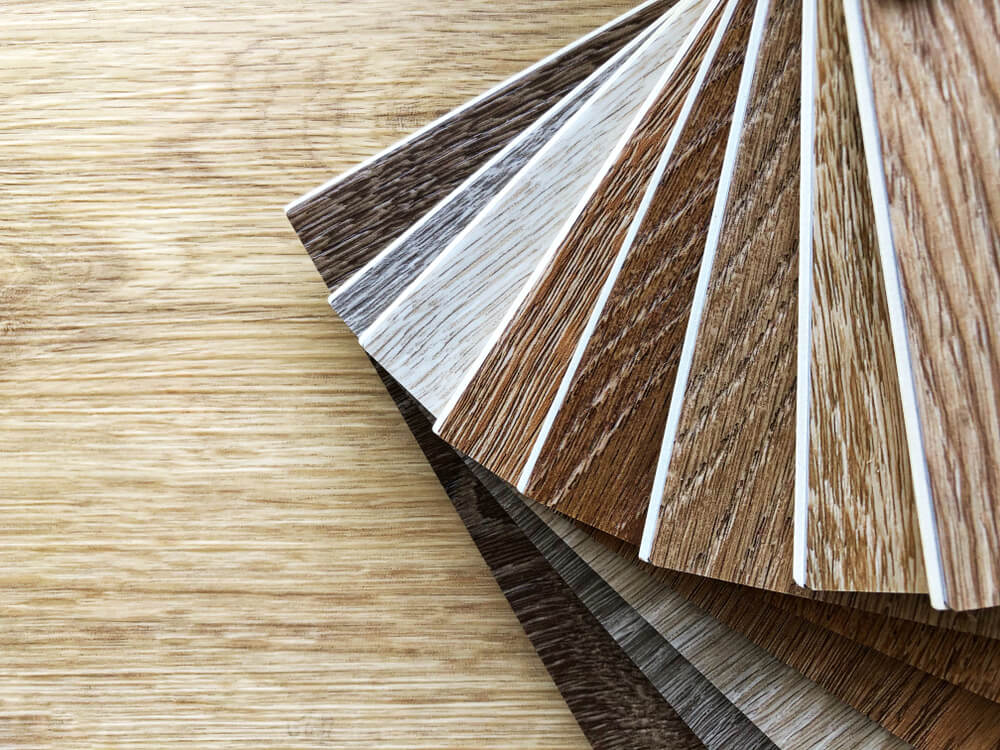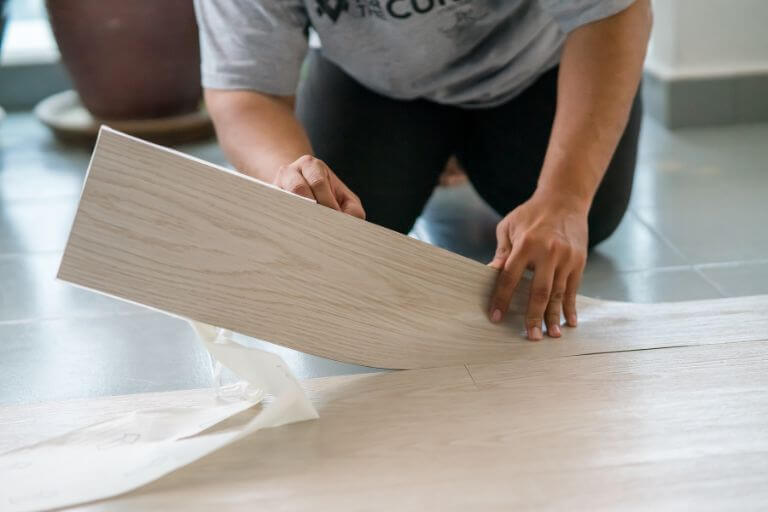Vinyl Flooring in the Kitchen: Advantages and Disadvantages

If you’re thinking about redesigning your kitchen and considering using vinyl flooring, it’ll be useful to know about the advantages and disadvantages.
This type of flooring has positioned itself well thanks to its incredible ability to imitate other materials such as wood. Not to mention that it’s seriously affordable too, which adds to the attraction.
Do you want to know more about using this option to renovate your kitchen floor? If so, keep reading and you’ll be able to make the best decision for your home.
Advantages of using vinyl flooring in the kitchen
Vinyl is a plastic coating that’s made up of several layers, which makes it quite resistant when compared to other types of flooring. It can be installed easily and without major work or effort. Although, of course, the amount of work required depends on the current condition of your kitchen.
Next, we’ll delve deeper into the advantages of choosing this type of flooring for your kitchen so you can give this room a whole new look.
Vinyl imitates other materials well

When it comes to having vinyl flooring in your kitchen, the main advantage that really stands out is that it imitates other materials well. Wooden or stone floors are quite expensive and require a lot of care and maintenance, but vinyl flooring is just as beautiful and it comes with the peace of mind that it’s also durable too.
It also imitates hydraulic, concrete, or cement floors too. The options are varied, so you can choose the one you want the most.
It comes in two different types
When it comes to kitchens, there are two types of vinyl flooring you can choose from. Firstly, you can find flexible vinyl, which comes in a continuous roll or in tiles. This is known as traditional vinyl flooring.
Secondly, there’s rigid vinyl flooring, which is much more modern and is considered more up-to-date. It also comes in tiles, but it’s known as LVT or engineered vinyl tile.
Both types are made from the same material, but they’re constructed in such a way as to produce different effects.
Installation doesn’t require effort
The next important advantage of using vinyl kitchen flooring is surrounding its installation, which may be the deciding factor. The rigid type of flooring, for example, can be installed over existing ceramic tiles, as long as they’re smooth.
Roll vinyl flooring requires a bit more work, but it’s nothing to get too concerned about. You’ll simply need to place another coating between the vinyl and your current flooring to hide the joints. Linoleum is a good option for this. But of course, if you already have an existing vinyl floor, it’s better to remove it before you install a new one.
It’s durable
Vinyl flooring is very durable, so you can use it in the kitchen without worrying. It stands up to everyday wear or abrasion and it’s also waterproof, so you don’t have to panic every time there’s a spillage. This makes it possible to clean it with water, unlike parquet or laminate flooring.
Finally, it’s non-slip, so you don’t have to worry about safety. Moreover, this flooring prevents bacteria from forming because its surface isn’t porous, and is sealed.

One of the disadvantages of vinyl flooring is that it can be damaged if your kitchen receives direct and constant sunlight.
The disadvantages of having vinyl flooring in the kitchen
When it comes to the disadvantages of having vinyl flooring in the kitchen, it must be said that the advantages far outweigh the disadvantages. However, it’s important that you know what you’re dealing with so that there are no unpleasant surprises.
- Pointed objects are their nemesis: ensure that knives or other sharp kitchen items don’t hit the floor. Unlike porcelain floors, for example, sharp objects can easily damage vinyl.
- Heat: vinyl can quickly become deformed if it’s exposed to temperatures above 113 degrees Fahrenheit. That’s why you shouldn’t use steam to clean this type of material.
- Direct sunlight: strong sunlight can discolor your vinyl kitchen floor. So it’s not recommendable to use this material in open spaces exposed to sunlight.
- Abrasive products: avoid using cleaning products such as those containing acetone or other solvents as they’ll destroy vinyl beyond repair.
- Heavy objects: these can mark your floor, so avoid them.
What do you think about having vinyl flooring in the kitchen?
As you can see, vinyl flooring has many advantages when you choose it for your kitchen. However, there are a couple of downsides that need to be considered. Before investing your money, check the condition of your kitchen floor so you can make the right choice.
If you’re thinking about redesigning your kitchen and considering using vinyl flooring, it’ll be useful to know about the advantages and disadvantages.
This type of flooring has positioned itself well thanks to its incredible ability to imitate other materials such as wood. Not to mention that it’s seriously affordable too, which adds to the attraction.
Do you want to know more about using this option to renovate your kitchen floor? If so, keep reading and you’ll be able to make the best decision for your home.
Advantages of using vinyl flooring in the kitchen
Vinyl is a plastic coating that’s made up of several layers, which makes it quite resistant when compared to other types of flooring. It can be installed easily and without major work or effort. Although, of course, the amount of work required depends on the current condition of your kitchen.
Next, we’ll delve deeper into the advantages of choosing this type of flooring for your kitchen so you can give this room a whole new look.
Vinyl imitates other materials well

When it comes to having vinyl flooring in your kitchen, the main advantage that really stands out is that it imitates other materials well. Wooden or stone floors are quite expensive and require a lot of care and maintenance, but vinyl flooring is just as beautiful and it comes with the peace of mind that it’s also durable too.
It also imitates hydraulic, concrete, or cement floors too. The options are varied, so you can choose the one you want the most.
It comes in two different types
When it comes to kitchens, there are two types of vinyl flooring you can choose from. Firstly, you can find flexible vinyl, which comes in a continuous roll or in tiles. This is known as traditional vinyl flooring.
Secondly, there’s rigid vinyl flooring, which is much more modern and is considered more up-to-date. It also comes in tiles, but it’s known as LVT or engineered vinyl tile.
Both types are made from the same material, but they’re constructed in such a way as to produce different effects.
Installation doesn’t require effort
The next important advantage of using vinyl kitchen flooring is surrounding its installation, which may be the deciding factor. The rigid type of flooring, for example, can be installed over existing ceramic tiles, as long as they’re smooth.
Roll vinyl flooring requires a bit more work, but it’s nothing to get too concerned about. You’ll simply need to place another coating between the vinyl and your current flooring to hide the joints. Linoleum is a good option for this. But of course, if you already have an existing vinyl floor, it’s better to remove it before you install a new one.
It’s durable
Vinyl flooring is very durable, so you can use it in the kitchen without worrying. It stands up to everyday wear or abrasion and it’s also waterproof, so you don’t have to panic every time there’s a spillage. This makes it possible to clean it with water, unlike parquet or laminate flooring.
Finally, it’s non-slip, so you don’t have to worry about safety. Moreover, this flooring prevents bacteria from forming because its surface isn’t porous, and is sealed.

One of the disadvantages of vinyl flooring is that it can be damaged if your kitchen receives direct and constant sunlight.
The disadvantages of having vinyl flooring in the kitchen
When it comes to the disadvantages of having vinyl flooring in the kitchen, it must be said that the advantages far outweigh the disadvantages. However, it’s important that you know what you’re dealing with so that there are no unpleasant surprises.
- Pointed objects are their nemesis: ensure that knives or other sharp kitchen items don’t hit the floor. Unlike porcelain floors, for example, sharp objects can easily damage vinyl.
- Heat: vinyl can quickly become deformed if it’s exposed to temperatures above 113 degrees Fahrenheit. That’s why you shouldn’t use steam to clean this type of material.
- Direct sunlight: strong sunlight can discolor your vinyl kitchen floor. So it’s not recommendable to use this material in open spaces exposed to sunlight.
- Abrasive products: avoid using cleaning products such as those containing acetone or other solvents as they’ll destroy vinyl beyond repair.
- Heavy objects: these can mark your floor, so avoid them.
What do you think about having vinyl flooring in the kitchen?
As you can see, vinyl flooring has many advantages when you choose it for your kitchen. However, there are a couple of downsides that need to be considered. Before investing your money, check the condition of your kitchen floor so you can make the right choice.







